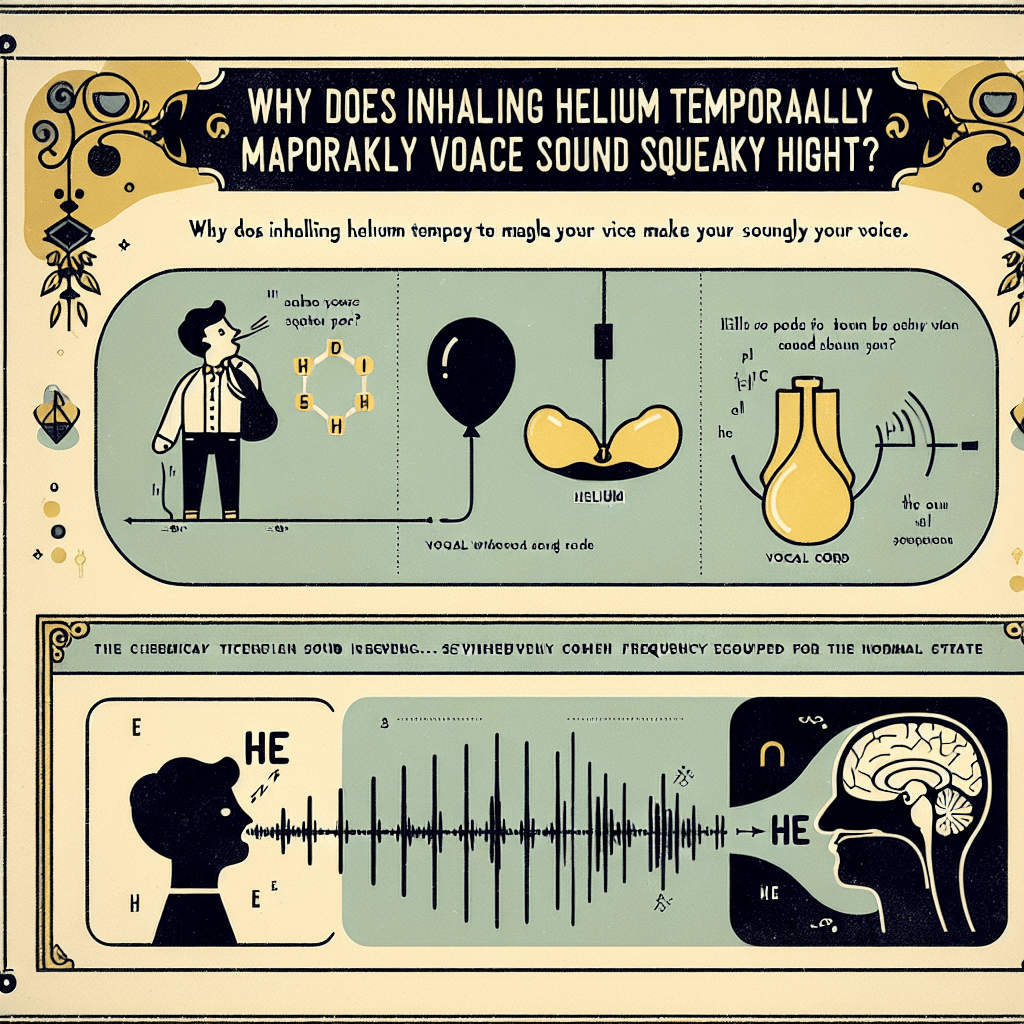Squeaky Science: Why Inhaling Helium Makes Your Voice High-Pitched
Ever wondered why inhaling helium makes you sound like a cartoon character? It's not magic—it's the fascinating physics of how sound travels through different gases.


Too Long; Didn't Read
Helium is less dense than air, causing sound to travel much faster through your vocal tract. This increases the resonant frequencies of your voice, resulting in a temporary high-pitched sound.
Squeaky Science: Why Does Inhaling Helium Temporarily Make Your Voice Sound High?
Ever been at a party, seen someone inhale from a balloon, and suddenly start talking like a cartoon character? That instantly recognizable, high-pitched, squeaky voice is a classic effect of inhaling helium. But have you ever stopped to wonder why this happens? It's not magic, but fascinating physics at play. Understanding this common phenomenon reveals intriguing details about how sound travels and how our own voices work. This post dives into the science behind the helium voice effect.
How We Normally Speak: Vocal Cords and Air
Before we introduce helium, let's quickly recap how we produce sound naturally.
- Airflow: Air expelled from your lungs passes through your larynx (voice box).
- Vocal Cord Vibration: Within the larynx are your vocal cords (or vocal folds). As air passes between them, they vibrate rapidly. The frequency of these vibrations primarily determines the fundamental pitch of your voice – faster vibrations mean a higher pitch, slower vibrations mean a lower pitch.
- Resonance: The sound produced by the vibrating vocal cords then travels up through your pharynx (throat), oral cavity (mouth), and nasal cavity. This entire area acts as a resonating chamber, much like the body of a guitar or violin. It selectively amplifies certain frequencies (called formants) and dampens others, shaping the raw sound from the vocal cords into the unique timbre and quality of your individual voice.
The air we normally breathe is a mixture of gases, primarily nitrogen (about 78%) and oxygen (about 21%). This mixture has a specific density.
The Speed of Sound: It Depends on the Medium
Sound travels as waves, and the speed at which these waves propagate depends significantly on the medium they are traveling through. A key factor influencing this speed is the density of the medium.
- Sound travels slower through denser mediums.
- Sound travels faster through less dense mediums.
Think of it like trying to run through water versus running through air – you move much faster through the less dense air.
Helium Enters the Picture: Lighter Than Air
This is where helium comes in. Helium (He) is an inert gas that is significantly less dense than the air we typically breathe – about six to seven times less dense, in fact.
When you inhale helium, it temporarily replaces the normal air mixture within your vocal tract (throat, mouth, nasal passages). Because helium is so much less dense than air, sound waves travel through it much faster. The speed of sound in helium is nearly three times faster than its speed in air.
The Real Reason for the Squeak: Resonance, Not Pitch Change
Here's the crucial part many people misunderstand: Helium does not actually change the fundamental pitch of your voice. Your vocal cords are still vibrating at roughly the same frequency as they normally would for the sound you're trying to make. You aren't suddenly tightening your vocal cords to hit higher notes.
So, why the squeaky sound? It's all about how that less dense gas affects the resonance within your vocal tract:
- Faster Sound Waves: The sound waves produced by your vocal cords travel much faster through the helium-filled resonating chambers of your throat and mouth.
- Shifted Resonant Frequencies: Because the sound waves are moving faster, the wavelengths that fit naturally within your vocal tract change. This causes the resonant frequencies (formants) of your vocal tract to shift upwards.
- Altered Timbre: Your vocal tract starts amplifying higher frequency harmonics more effectively than it normally would, while suppressing lower ones. This change in the emphasis of different frequencies alters the overall quality, or timbre, of your voice.
It's this change in timbre – the amplification of higher frequencies – that our ears perceive as a high-pitched, squeaky, "chipmunk" sound. The fundamental pitch is largely unchanged, but the character of the sound is drastically different.
A Word of Caution: Safety First!
While the helium voice effect is amusing, it's important to be aware of the potential dangers. Inhaling helium displaces the oxygen your body needs. Taking more than a tiny breath from a balloon can lead to dizziness, lightheadedness, or even loss of consciousness due to oxygen deprivation (asphyxia). Never inhale helium directly from pressurized tanks, as the high flow rate and extreme cold can cause serious lung injury or even be fatal. The party trick is best enjoyed in moderation, if at all, using only small amounts from party balloons.
Conclusion: Sound Science in Action
The temporary squeaky voice caused by inhaling helium isn't due to a change in your vocal cord vibrations but rather a fascinating consequence of physics. By replacing the air in your vocal tract with the much less dense helium, you significantly increase the speed of sound traveling through that space. This shifts the resonant frequencies upwards, altering the timbre of your voice and making it sound comically high-pitched. It’s a simple yet powerful demonstration of how the properties of a medium can fundamentally change the way we perceive sound – just remember to prioritize safety over novelty.


